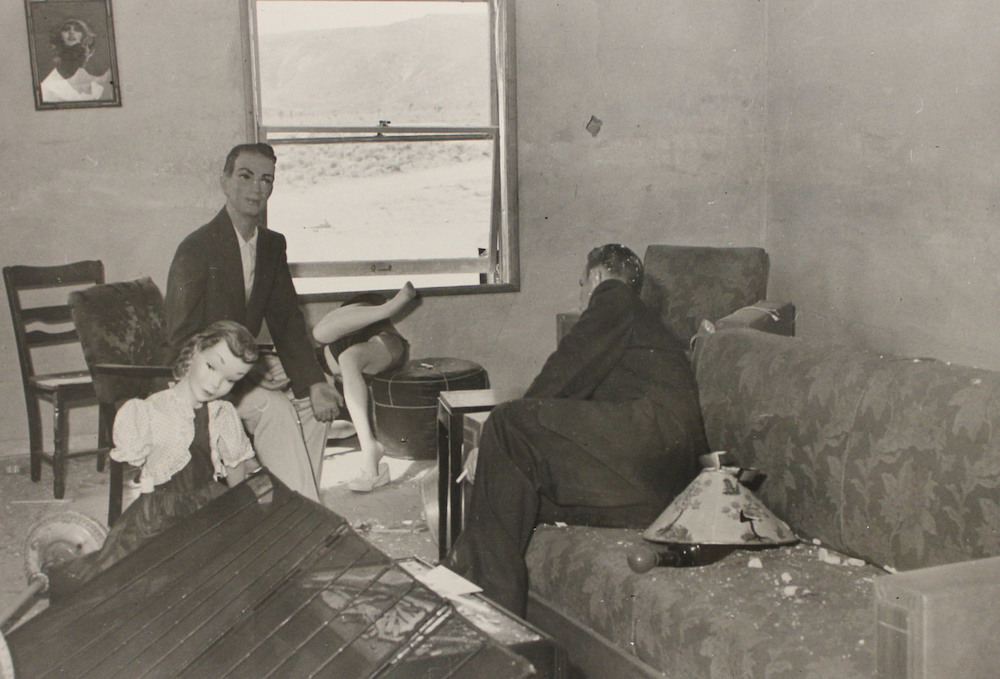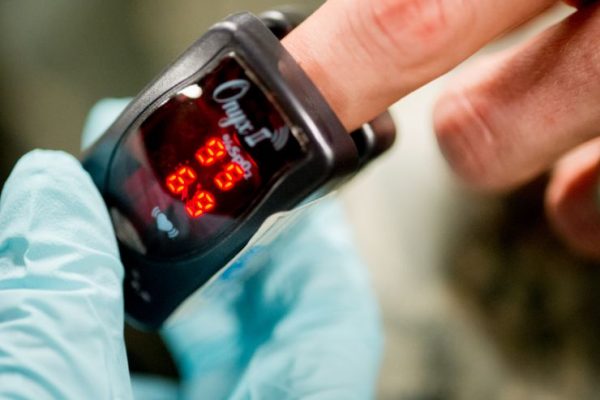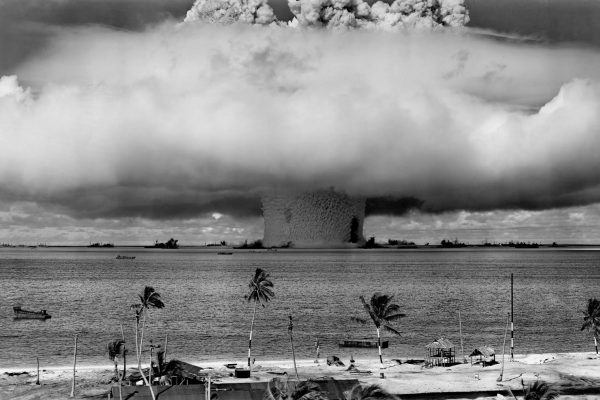The detonation occurred at 5:20 a.m. Somewhere in the desert expanse of Yucca Flat, an atomic bomb exploded with the force of 15,000 tons of dynamite and the brightness of several suns. Two miles away, meanwhile, crowds of observers bussed in from Las Vegas for the occasion watched as the mushroom cloud formed what one witness would later call a “stairway to Hell.” It was 1953, and bomb drops in the Nevada Proving Ground could no longer be said to be an unusual occurrence, but Operation Doorstep, as it would be designated, was not a regular test. It was a civil defense test—the first of its kind—meant to assess not just the force of an atomic blast but U.S. preparedness in the event of a Soviet first strike. Instead of simply targeting sand, the explosion detonated over purpose-built houses and cars brought in for the occasion. Pantries were stocked, living rooms furnished, mannequins positioned on sofas or dining room tables, stoically awaiting their fate. And as the irradiated dust settled across the scraggles of sagebrush, a team of men in protective suits went forth to see what the explosion had wrought.
Many things are deeply strange about Operation Doorstep, but two elements call out for closer scrutiny today. The first is that the mannequins who inhabited the ersatz town were all white, having been donated by a Las Vegas Sears. The second is that the houses targeted by the bombing—“typical American frame dwellings,” in the words of one propaganda film produced in the test’s aftermath—were the kinds of spacious two-story structures one would expect to find in segregated suburban communities like the several Levittowns scattered across the country. The residents of such commodious homes would have the space and the money to install a well-appointed outdoor bomb shelter of the type recommended by the organizers of Operation Doorstep; failing that, they might clear some space in their roomy basement for a lean-to or box-type shelter. Yet a strategic attack was far more likely to hit a dense urban center than it was a sprawl of tract housing—and its victims were far more likely to be low-income people of color with neither the space nor the resources to abide by the rosy recommendations of the Federal Civil Defense Administration (FCDA).
The whiteness of Operation Doorstep was not a fluke: white supremacy was a core part of both the U.S. nuclear program and the country’s civil defense throughout the Cold War. In a 1963 op-ed entitled “Can Negroes Survive a Nuclear War?” sociologist Nathan Hare excoriated the all-in-this-together attitude of public civil defense messaging, arguing that such official cheer flew in the face of the facts on the ground. “Negroes in our big cities now live in bulls-eyes enclosed by white satellite suburban rings,” he wrote. “Mo re than nine out of ten of all Negroes living outside the South . . . live in cities.” For many of these citizens, the types of preparedness strategies modeled in Operation Doorstop were an impossibility:
With an average income about $2,000 smaller than the average white family’s, and with more mouths per family to care for, the typical Negro could n’t afford a shelter if he wanted to. Not that this makes that much difference; slum dwellings and shelters near the center of the city would amount to incinerators anyway.
Throughout the atomic age, civil defense authorities demanded the active participation of Black citizens whom their measures failed to protect. At the same time, white bureaucrats were regarding the prospect of a post-attack future—one in which the infrastructures that reinforced white supremacy were at least temporarily knocked out—with increasing unease. For those in power, the prospect of nuclear carnage was as terrifying as the collapse of the racist hierarchies it had the potential to cause.
“Sundays, holidays, vacation time—we must be ready every day all the time to do the right thing if the atomic bomb explodes,” intones the fatherly voice-over narration of “Duck and Cover” (1951) as a picnicking family sees a flash of light in the distance and hurriedly throws their blanket over themselves for protection. Intended for elementary schoolers, the short film was created to provide exemplars of nuclear preparedness to young students across the United States: various scenes show children sheltering under desks, in doorways, beneath bus seats, all at a moment’s notice and with perfect calm. For the FCDA, which funded the film, the ideal citizen—whether child or adult—was always vigilant, primed to react to an attack at any second: “No matter where they go or what they do,” as the narrator puts it, “they always try to remember what to do if the atom bomb explodes right then.”
Created in 1950, the FCDA was tasked with readying civilians for nuclear warfare, making of the entire United States one great attenuated battlefield and its populace a nationwide reserve corps. Propaganda material produced by the agency made clear that through preparing for the possibility of attack, civilians were protecting not just themselves but the nation as a whole. The vexing question of how this protection could best be undertaken would receive various answers over the years. What remained constant, however, was the agency’s privileging of white life over the lives of all others.
Throughout the midcentury, the U.S. government’s civil defense propaganda overwhelmingly featured images of white people, especially white nuclear families. Material aimed at American farmworkers, for example, addressed not the many Asian Americans and Latinos working in California’s Central Valley or the farmers in the Black Belt but white midwestern smallholders, who were romanticized as the defenders not merely of the country’s food supply but of its bedrock moral values. Even works explicitly about Japan were not immune from whitewashing: the 1948 edition of John Hersey’s Hiroshima featured on its cover a painting of a white couple fleeing a nuclear blast. Explaining his design, illustrator Geoffrey Biggs stated that he “just drew two perfectly ordinary people—like you or me.” Here and elsewhere, the terror surrounding nuclear weapons seemed to be rooted not in a retrospective look at the damage they had wrought in the past, nor even in a generalized anxiety that they might be used in the future, but very specifically a fear that this time, the target would be American suburbia.
The FCDA’s complicity in white supremacy was brought to national attention in 1950 when President Harry S. Truman nominated Florida governor Millard Caldwell to head the agency. To Truman’s surprise, what he’d meant to be a sinecure appointment quickly became a hot button issue when NAACP members around the country protested his choice, citing Caldwell’s long-held segregationist sympathies. As an editorial in the NAACP’s magazine, The Crisis, points out, Caldwell had looked the other way after lynchings and supported whites-only primaries as governor; now, he was proposing a multi-billion-dollar national bomb shelter program that would allow for segregated shelters and civil defense corps, effectively extending Jim Crow into the post-apocalyptic age.
Caldwell’s collective shelter plan proved immensely politically unpopular. Such a massive building project came with a blistering price tag (speaking before the Senate, he declared that $3 billion would not be enough to safeguard even 1 percent of the U.S. population), and for many it seemed dangerously communistic in its appeals to collectivism. But another important factor was white fears of racial mixing during a prolonged stay in a desegregated fallout shelter. One government-commissioned report from 1950 warned of the racial violence that would follow a nuclear bomb blast, particularly in cities with large minority populations: “It is awesome to reflect on what would happen . . . if colored people and white people were forced into close association in shelters, in homes, and even in evacuation reception centers.” As sociologist John Preston argues, civil defense officials pathologized the response of minorities to disasters, particularly in an imagined scenario where the government would be unable to enforce the existing racial order with the threat of state violence.
Largely retreating from the collective model, the FCDA instead embraced an individualized civil defense scheme in which every household would be responsible for building a private shelter, stocking it with adequate provisions, and otherwise ensuring that their home was bomb proof. Propaganda materials, meanwhile, scolded unscrupulous homemakers for being a threat to national security. In one 1953 FCDA film about the effects of atomic bombs on buildings, a virtuous homeowner is able to guarantee that their home will weather the blast thanks to “better, safer housekeeping,” while their messy neighbor dooms themselves by leaving “newspapers lying about” and “a shirt hanging in the corner.” In another part of the film, a mocked-up yard full of scraggle grass, dead leaves, and debris is vaporized almost instantly, a simulation of what the narrator sternly notes will happen to “slum areas.” The corollary to the popular image of orderly and well-prepared suburb was that of the sitting-duck city doomed by the apathy and slovenliness of its own residents—adding another layer to the highly racially charged depiction of urban areas as places of danger, decay, and political subversion. Indeed, some designers and science fiction writers even saw in atomic blasts a kind of opportunity in disguise, as the destruction would effectively act as a form of slum clearance and allow for the rebuilding of a cleaner, greener, and (presumably) whiter city.
Most urbanites could not hope to conform to the FCDA’s ideals even if they wanted to: high-rise dwellers had no basement to take cover in, no yard in which to excavate a shelter. As the United States Strategic Bomb Survey noted in 1946,
the overwhelming bulk of the buildings in American cities could not stand up against an atomic bomb bursting a mile or a mile and a half from them. . . . The casualty rates at Hiroshima and Nagasaki, applied to the massed inhabitants of Manhattan, Brooklyn, and the Bronx, yield a grim conclusion.
Given this fact, civil defense leaders decided that the best hope for city dwellers was evacuation: residents of urban targets would escape to the countryside, where they would be cared for by farmers and townsfolk for an indeterminate amount of time. This scheme immediately raised the ire of many white would-be hosts, who viewed the prospect of evacuees of color arriving in their neighborhoods as a hostile “invasion.” Marjorie Husted, the voice of Betty Crocker, described it as such in a speech at an FCDA event in 1954.
But while suburbanites shuddered at the thought of non-white refugees arriving in their monoethnic enclaves, the disturbing reality was that if a bombing occurred, many of these people would never make it out of the city. Despite governmental assurances, evacuation plans were often poorly thought out, lacking in concrete detail, and structurally biased against low-income urban residents of color. In a test evacuation of Mobile, Alabama, dubbed Operation Scat, many Black residents were forced to flee on foot, as the city’s Black neighborhoods had low rates of car ownership and a dearth of public transit. The National Academy of Sciences, which observed the exercise, later chided the FCDA officials involved for their paltry outreach to the Black community, which sowed panic that the drill was actually a real bombing targeting Mobile’s Black population as punishment for recent desegregation efforts. Historian Laura McEnaney speculates that the FCDA’s refusal to cooperate with the NAACP on outreach and logistics was deliberate; as she concludes, “Operation Scat would later prove . . . [that] Jim Crow would survive a nuclear attack.”
McEnaney’s assessment would be borne out in official civil defense plans like the school evacuation scheme devised by Savannah, Georgia. In the event of a nuclear bombing during class time, white and Black students were to board segregated train cars for escape from the city, after which they would be billeted in separate towns according to their race. Small clusters of white students were spread out over many communities to make sheltering them easier. By contrast, the plan threw large groups of Black students into towns with populations sometimes half that of their evacuee contingent, giving little thought to how such an imbalance would affect the care these children received. The fact that norms of segregation were expected to persist even in the aftermath of a cataclysmic attack was, in the words of geographers Jonathan Leib and Thomas Chapman, “both absurd and unremarkable.” For the white designers of civil defense measures, it was easier to imagine a post-nuclear world than it was to imagine an end of white supremacy.
Could even the most well-prepared citizen—the quickest duck-and-coverer with the most solidly built bunker and the best-stocked emergency larder—survive a nuclear bombing unscathed? Civil defense bomb tests used weapons that were many times less powerful than the latest technology in an attempt to project as reassuring an image as possible. A special civil defense-themed issue of Life in September 1961 declared that with proper preparation, 97 percent of Americans could survive in the event of a nuclear war. But despite the smiling face the FCDA projected to the world, internal projections were grim. A 1963 report modeling a nuclear attack predicted 72 million deaths from the initial blasts—and that number that did not take into account subsequent deaths from things like a breakdown in the food supply, the collapse of medical services, and so on. The safety promised by U.S. civil defense programs, then, was largely imaginary—but the fact remains that their architects cared so little for people of color that they did not even extend them imaginary safety.
This disregard for urban minorities, particularly Black people, when it came to civil defense was paralleled in the racism that was foundational to the United States’s nuclear arms program. As Elaine Scarry has observed elsewhere in these pages, white supremacy undergirded everything from the decision to bomb Japan to the forced relocation of Pacific Islander communities to make way for test sites. Decades after their closure, uranium mines continue to leak pollution onto the Navajo Nation, whose residents had once worked below-minimum-wage jobs with no safety equipment in order to supply U.S. weapons with the material they needed to function. And the land that would become the Nevada Proving Ground —which would see almost a thousand weapons tests conducted above and beneath its soil—was seized from the Western Shoshone and Southern Paiute nations, a direct violation of the U.S. government’s treaty obligations that led to the desecration and destruction of sacred sites. Generations of so-called “downwinders”—those living within range of nuclear test fallout —have suffered severe health problems as a result of their exposure. A study by Clark University found that Native children in Duckwater, Nevada registered thyroid radiation levels several thousand times higher than average, while oral histories taken by the photojournalist Carole Gallagher record cancer, sterility, miscarriages, premature deaths.
Given all of this, it is not surprising that Black activists were central to the nascent nuclear disarmament movement, with W. E. B. Du Bois and others seeing in the atomic bomb the fusion of American racism at home and abroad. Langston Hughes repeatedly called the FCDA’s bluff in his satirical Simple stories, so called for the nickname of their main character. Simple grimly predicts that if nuclear war ever came, he would be “Jim Crowed out of bomb shelters.” His only shot, he said, would be if white people decided to let in Black evacuees because they were in need of servants. His interlocutor is incredulous: “Bomb shelters will be for everybody,” he insists, ever a believer in American benevolence. Simple’s reply: “Not in Mississippi.”







